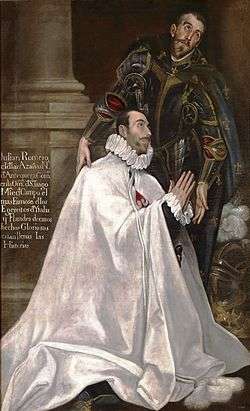Julian Romero

Julián Romero de Ibarrola (Huélamo, 1518 – Cremona, 1577) was a Spanish military commander in the 16th century. He was one of the few common soldiers in the Spanish army to reach the rank of Maestro de Campo.
Romero was born in Huélamo, Province of Cuenca (Spain). Nothing more is known about his youth. He entered the Spanish army at the age of 16, and was stationed in Flanders. By 1545 he commanded a Spanish army unit as sergeant or captain in the Battle of Pinkie Cleugh, as ally of the English in their war with Scotland. King Henry VIII of England was so impressed by his performance, that he made him a banneret. Shortly after, he was recalled from England, because the alliance with Spain came to an end when King Henry converted to Protestantism. Romero fought in the Italian War of 1551–1559, where he distinguished himself in the Battle of St. Quentin (1557), for which he was made a Knight in the Order of Santiago.
In 1565 he was stationed in Sicily, but the following year, the Duke of Alba made him Maestro de Campo, and he accompanied the Duke to the Low Countries to crush the Dutch Revolt. In 1568 he commanded the guard at the execution of Counts Egmont and Horn.
Romero fought in the Siege of Mons (1572), where he nearly succeeded in killing William the Silent in a daring raid against the Dutch camp. He was also present at the Spanish Fury at Naarden and the Siege of Haarlem, where he lost an eye. In 1574, he failed to relieve Middelburg after losing the Battle of Reimerswaal, and in 1576 he was present at the Sack of Antwerp.
By the Edict of 1577, most Spanish troops were withdrawn from the Low Countries and Romero was stationed in Cremona, where he died before he could return to the Low Countries at the end of the year.
After his death
After his death, Julian Romero became in Spain a military hero who gave his life for his country.
He was painted by El Greco around 1612 and José de Cañizares dedicated a play to him (El guapo Julián Romero) in the 18th century.
References
- this article incorporates text translated from Spanish Wikipedia